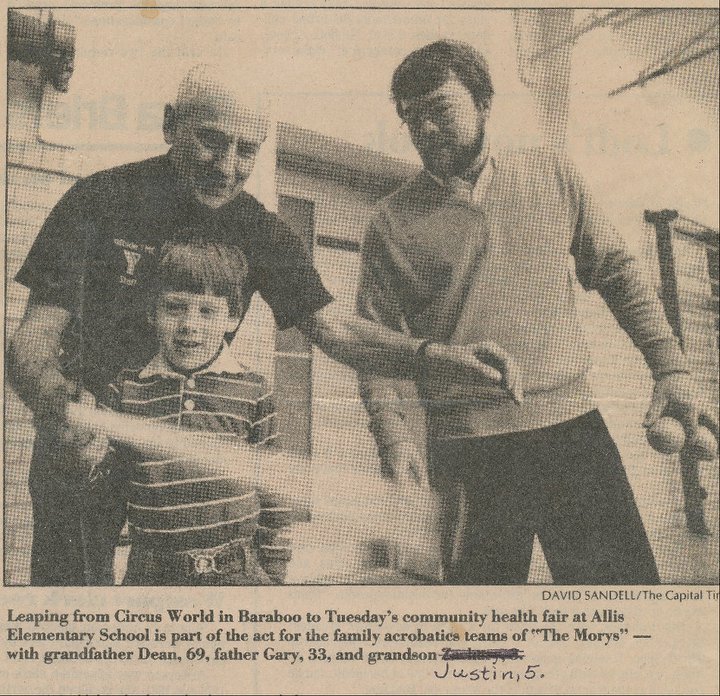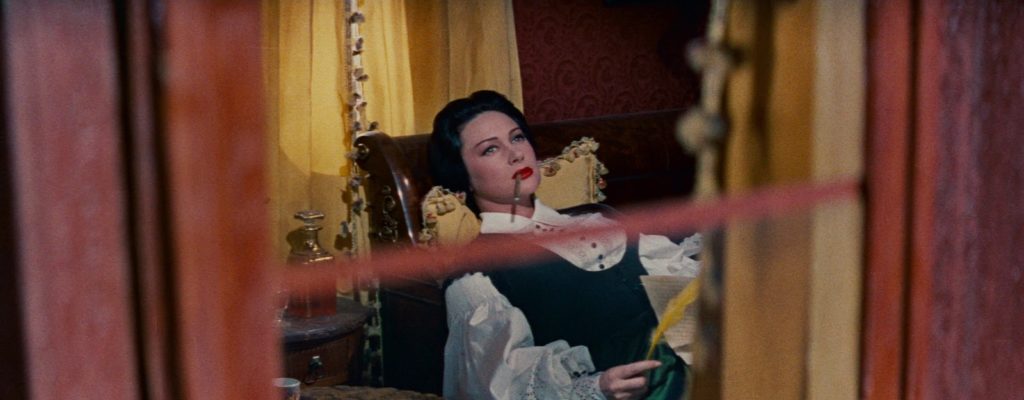26 That’s Right 26 Selections Of The Greatest Circus Movies On Earth!
Part IV: The Greatest Of The Greatest Shows On Earth
Concluding my grandfather Dean Mory’s lifelong circus saga, we come to my very first direct memories of the man whose experiences over the past three parts precede my own birth by 64 years. In pages of now misplaced photo albums, one might find several fading and yellowed instant-developing Polaroids of my three-year-old self with a baby tiger on my lap, or crying backstage at the Big Top while being held by a wide-red lipped and motley-dressed Happy the Clown, or standing atop a giant wooden elephant platform with a group of cousins during a summer 1980 visit to Circus World Museum. Paging through subsequent volumes, one might find Grandpa spotting a waist high-length me on his gymnasium-basement trampoline or holding my precarious balance on a walking globe or, by this time taller than the bald-domed older man by a hawk-pointed nose, passing juggling clubs between us in his half-acre size suburban backyard.
What I’ve most worried about in these prefacing accounts of my grandpa’s performing exploits and career accomplishments is giving a false impression of his essentially reserved and surprisingly modest personality. Indeed, behind the low-key facade of a man given to the cracking of an occasional corny joke or intently listening to a louder old friend’s account of a raucous Prohibition-era college soiree – gently correcting when the exaggerations strained the bounds of credulity – was an engaging performer who was capable of “physical miracles”, as eloquently described by eulogist John Zingaro at Grandpa’s funeral in the fall of 2004, aged 91-years-young. “Send me a postcard” was the last thing I remember him saying to me shortly before leaving for South Korea a few weeks before his death, and though I never got a chance to, I have certainly wondered since what image of foreign exoticism might have captured the imagination of a man who had seen – and first-hand experienced – just about everything life has to offer.
As a small child I can barely remember Grandpa mentioning the circus at all, much less his involvement in it, but I do vividly recall his juggling, unicycling, and barbell workouts, along with the yearly gifts of vintage circus posters – “World’s Greatest Circus!” “Greatest Show On Earth!” “Peerless Prodigies Of Physical Phenomena!” – that wall-to-wall decorated the childhood bedroom I shared with my younger brother. For better or worse, that exclamatory verbiage – along with the vivid and panoramic imagery I fell asleep to and dreamed of as a kid – has, as these pages might show, undoubtedly shaped my visual imagination, small talent of description, and undoubtedly long-winded style of expression.
More a state of mind than an actual, physical location, the circus also existed purely and spectacularly in the imagination, and as its practitioners traveled from town-to-town and engagement-to-engagement – entirely lacking a fixed location either in performance or venue – brought out the magical qualities that exist far beyond the realm of everyday life and, for a few hours, made the impossible possible. A 5’6” elderly guy in a red Badgers flat-cap shuffling down the aisle at the local grocery store might not have looked it, but he was once capable of forming hand-balancing human pyramids, swinging and twisting 30 feet above the ground, and lifting his entire body weight over his head.
That visual and physical deception lies at the heart of the circus, and further reminds me of an anecdote with which I’ll conclude this introductory account of my grandfather’s circus life. In the early ’90s, when Grandpa was in his late 70s, my dad was helping him clean out the rain gutters of his one-story home one fall afternoon. The ladder, old and rickety, was propped off the deck in the backyard, with Grandpa balancing off the top rung and hand-scooping out the clogged gutters of fall leaves while Dad firmly held the ladder below. Suddenly, and without warning, the metal clasps holding the top and bottom sections gave way and the ladder folded inwards, throwing the balance of the ladder backwards, quickly crashing towards the ground. Feeling the ladder buckling beneath, Grandpa in that split-second jumped off the top rung, twisted mid-air, and landed on his feet with a practiced flourish next to my dad, the other half of the ladder lying in pieces behind them.
A septuagenarian’s final stunt – punctuated by a sly wink and a muttered “Well, shoulda bought a new ladder…” – for me sums up the aspects of performance, oddity, and spectacle covered heretofore on this list of circus movies. Like his house with the 3-ring circus in the basement, or the classes delivered at the top of a rope, or the hand-stands from the tops of tall buildings in his youth, appearances were deceiving with Dean Mory, and my quiet and unassuming grandfather spent his circus life upsetting expectations of all size, scale, and manner.

…
At the end here, we have one remaining, 26th circus movie selection to cover before folding the tents on this movie marathon, 10,000 word-plus article, and, yes, the circus itself. Ending its SUPER! COLOSSAL! MONUMENTAL! run of 146 years this past May, the Ringling Brothers and Barnum & Bailey Circus has put its Greatest Show to rest in its final tour, and with it passing a tradition of live performance, variety exhibition, animal menagerie, and general curiosity that will never be seen again on its scale. I think the world will be a little poorer for its absence, though possibly the circus will live on in shadow revivals of its spirit, while continuing to stir the imagination with its memory and legacy.
This movie list, one hopes, has attempted to highlight some of the great circus movies of all time, but the inescapable conclusion reached by a more comprehensive survey of the subject is that no one, single movie captures the length and breadth of the Big Top or its 3 performing rings; its panoramas and calliope-driven beats of sights and sounds “defying definitive description!” But in considering the three previous thematic sections of performance, oddity, and spectacle, I would like to conclude this four-part article with a circus movie that I believe has come closer to embodying those tripartite aspects of the circus better than any movie yet made.
Mein Damen und Herren, Mesdames et Messieurs, Ladies and Gentlemen! Curiosity seekers of all manner, interest, or estate! Sparing no expense, risk, or ambition, Mammoth Circus has recently engaged a figure of notoriety on such a momentous scale that she embodies in her mere person the tragic sweep of an entire continent and century! Loved by emperors, great artists, and celebrated personages of all stamp and character, the modern age has both bowed and repulsed in admired and shocked accord to one, singularly notorious woman!
Lola Montès
1955, France, dir. Max Ophüls

The camera swings, swoops, and veritably swirls through four of the nineteenth century’s most tumultuous decades, as seen through the widescreen lens of CinemaScope, the painterly vistas of Technicolor, and through extravagant period settings and costumes. Telling the story of infamous courtesan Lola Montez (1821 – 1861), a one-time dancer who in her mere 39 years cut the most scandalous of swaths imaginable through France, Switzerland, Germany, and the United States, the mid-1800s were undoubtedly a good deal more interesting for her outsize exploits in life, love, and on the (world’s) stage.

Framing those described exploits in a manner brilliantly suited to this list’s most overused descriptor, “outsize” does indeed descriptively capture the filmmaking and storytelling tools employed by director Max Ophüls; and while the historical Lola Montez ended her life and storied career recounting same on a public speaking tour through pre-Civil War America, Lola Montès re-imagines the sedate town hall, auditorium, and lectern format of Lola’s real-life speaking engagements as a spectacle of clowns, jugglers, minstrels, lions, tigers, dancing bears, 3-ring, Big Top EXTRAVAGANZA! Backed by a forcefully demonic though vaguely neurotic ringmaster (Peter Ustinov in a tour-de-force, multilingual performance), Lola’s life-challenging performance in Louisiana’s fictional Mammoth Circus screen-magnificently captures the visual and auditory splendor of a turbulent chapter of history, the then emerging performance aspect of the circus, and a life rather spectacularly lived.

As portrayed by Martine Carol, Lola is as cold and remote as the reaction she provokes in lovers, ranging from a penniless young student (Oskar Werner) to Bavaria’s King Ludwig I (Anton Walbrook), is warm and passionate; as distant and impassive as the loyalty she inspires in her longtime maid (Paulette Dubose) and coachman (Henri Guisol) is deep and unyielding. A visual cipher on screen through her own mother’s shipboard “arrangement” – at the age of 14 – with an older, wealthy gentleman, her early marriage to an abusive cavalryman (Ivan Desny), and her decidedly unromantic though frankly empowering “disposal” of Romantic-era musicians Franz Liszt (Will Quadflieg) and Claudio Pirotto (Claude Pinateau), Lola’s career as courtesan is crowned by a moment when she literally rips off her bodice before the aforementioned Bavarian King – in order to prove the “genuineness” of her womanly attributes – and so earns the aristocratic title of Countess of Landsfeld even as the astonished monarch calls for a needle and thread. (The latter sequence of which is a lavish screen spectacle in and of itself.)

Through it all, even as the entire foundation of both her rapidly rising career and sprawling Bavarian estate is visually and visibly rattled by protestors and revolutionaries, Lola maintains an almost eerie equanimity – equal to the Mona Lisa-like calm exuded in a portrait the Bavarian King commissioned during their courtship – that is only broken when later forced by the downfall her life becomes to re-enact those same passages of her astonishing career before a panoramic audience of New Orleans circus-goers. With the Mammoth Circus Spec’s doubling, costuming, and dangerous tight-rope, trapeze, and height-falling acts – coins for concessions are collected in plaster molds of Lola’s likeness, while the climactic “drop” plunges the performer into an unequivocal stew of pink, gelatinous womanhood – the colored spotlights across La Belle Lola’s face finally betray the sweat on her brow, a breathless spasm of artery-constricted heartbeats, and a momentary flash of fear and anguish as she answers the ringmaster’s final call before her show-stopping, curtain-calling, possibly life-ending stunt: “Ready.”

…

As the camera dollies back across a seeming mile of circus patrons queuing for the silver dollar-paid honor of kissing her hand – Lola’s icy composure regained as ensconced, porcelain doll-like, in a freak sideshow or jungle menagerie cage – Max Ophüls’ Lola Montès symbolically fuses those performing, oddity, and spectacle circus themes covered in the previous 25 films and 11,000 words through one breath-taking, back-tracking shot. This circus movie fan lives in hope that another film may rise to challenge its pinnacle place in the pantheon of Big Top, big screen stories, but until then, the adjectives-superlative vision of history and its impact on an infinitely-replicated present – and a performer on life’s stage literally performing herself to death – finds its greatest, most daring, and dramatically safety net-less expression in these 114 restored, revitalized, and re-realized minutes of circus glory.

